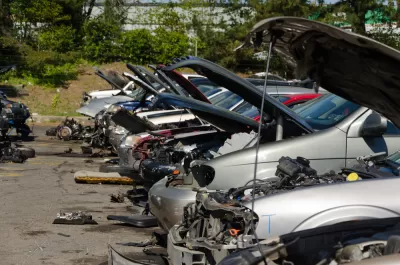A hopeful forecast predicts that thousands of monthly traffic collisions will be avoided due to reduced vehicular travel during California’s shelter-in-place period.

A U.C. Davis survey finds that auto collisions have been curbed by more than 50 percent since the stay-at-home orders went into effect around the state of California in March. "The survey suggests that a 60% drop in traffic volume — when compared with the same period last year — accounts for a roughly 50% decline in collisions on roadways policed by California Highway Patrol," writes Louis Sahagun.
The U.C. Davis Road Ecology Center's "California Highway Incident Processing System," which tracks close to real-time traffic data in California, reported only 500 collisions in the period between March 21st and March 30th, a significant reduction from the 1,116 collisions observed in the ten-day period between March 10th and March 19th. The decrease in vehicle travel and traffic volume resulting from the state-wide order also correlates to a reduction in fatality and injury caused by collisions.
Road Ecology Center co-director Fraser Shilling was unable to assess animal fatalities on public roadways, the main focus of his research, due to the lack of data in the short time period. Shilling hopes to center future research on "cost-savings and other social benefits from reduced injuries and deaths on state highways due to COVID-19."
FULL STORY: Coronavirus stay-at-home orders have reduced traffic accidents by half

Planetizen Federal Action Tracker
A weekly monitor of how Trump’s orders and actions are impacting planners and planning in America.

Congressman Proposes Bill to Rename DC Metro “Trump Train”
The Make Autorail Great Again Act would withhold federal funding to the system until the Washington Metropolitan Area Transit Authority (WMATA), rebrands as the Washington Metropolitan Authority for Greater Access (WMAGA).

The Simple Legislative Tool Transforming Vacant Downtowns
In California, Michigan and Georgia, an easy win is bringing dollars — and delight — back to city centers.

The States Losing Rural Delivery Rooms at an Alarming Pace
In some states, as few as 9% of rural hospitals still deliver babies. As a result, rising pre-term births, no adequate pre-term care and "harrowing" close calls are a growing reality.

The Small South Asian Republic Going all in on EVs
Thanks to one simple policy change less than five years ago, 65% of new cars in this Himalayan country are now electric.

DC Backpedals on Bike Lane Protection, Swaps Barriers for Paint
Citing aesthetic concerns, the city is removing the concrete barriers and flexposts that once separated Arizona Avenue cyclists from motor vehicles.
Urban Design for Planners 1: Software Tools
This six-course series explores essential urban design concepts using open source software and equips planners with the tools they need to participate fully in the urban design process.
Planning for Universal Design
Learn the tools for implementing Universal Design in planning regulations.
Smith Gee Studio
City of Charlotte
City of Camden Redevelopment Agency
City of Astoria
Transportation Research & Education Center (TREC) at Portland State University
US High Speed Rail Association
City of Camden Redevelopment Agency
Municipality of Princeton (NJ)





























